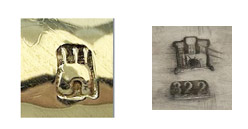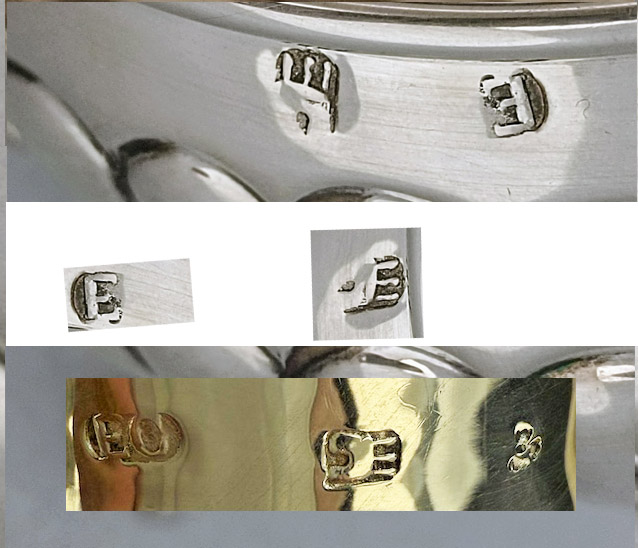Master EC in a German town with 3 towers?
Re: Master EC in a German town with 3 towers?
:::: It's just seems so extremely heavy for a creamer. :::::: It seems very unusual to find a piece that weighs twice as much as other examples (I have seen this on a muffineer before, I have a 10-ounce muffineer and I found another one with the exact same dimensions and it weighs 18-ounces or something crazy like that, so it's not unheard of to find an object that weighs much more than its counterparts, but it is so rare that I just wondered if there could be another reason for the increased weight. ::::::::
Re: Master EC in a German town with 3 towers?
Very good observation. Thank you! I never doubted that it was silver and I didn’t test it. At the moment and in the next weeks the jug is out of my reach. I can’t imagion that it isn’t silver but I will have it tested.
Re: Master EC in a German town with 3 towers?
:::: I did consider that this could be an Italian forgery, but I was unfamiliar with which Italian city-state the hallmarks are imitating, and why are the hallmarks in the traditional English location on a creamer? ::::::
::::: " In the 1950s Italian silverware production grew exponentially obtaining a worldwide success. A myriad of new factories and small workshops were opened and flourished domestic and international silverware business.
In this context some manufacturers continued the practice to use, next to the official hallmarks (800 and lozenge), one or more pseudo-hallmarks similar to those used in the 19th century pre-unification states.
The pseudo-hallmarks were intended to embellish decorative objects made in 19th century style. This practice was widely used by Bruno Zaramella factory, a large manufacture operating in Padova/Padua, a town near Venezia/Venice in Veneto region.
The coexistence of the modern marks excluded fraudulent objectives and the pseudo marks were intended only as a token of the inheritance to the ancient local tradition in silver workmanship.
Obviously, these "modern" objects were sold by Jewelry dealers and not through Antiques Shops." :::::
"Forgeries In Italian Silver".
::::: " In the 1950s Italian silverware production grew exponentially obtaining a worldwide success. A myriad of new factories and small workshops were opened and flourished domestic and international silverware business.
In this context some manufacturers continued the practice to use, next to the official hallmarks (800 and lozenge), one or more pseudo-hallmarks similar to those used in the 19th century pre-unification states.
The pseudo-hallmarks were intended to embellish decorative objects made in 19th century style. This practice was widely used by Bruno Zaramella factory, a large manufacture operating in Padova/Padua, a town near Venezia/Venice in Veneto region.
The coexistence of the modern marks excluded fraudulent objectives and the pseudo marks were intended only as a token of the inheritance to the ancient local tradition in silver workmanship.
Obviously, these "modern" objects were sold by Jewelry dealers and not through Antiques Shops." :::::
"Forgeries In Italian Silver".
Re: Master EC in a German town with 3 towers?
It is possible that it is an Italian fake from the 50s, as Aguest says.
Indeed the mark on the zilverik's jug has a very vague resemblance to the "torretta" the guarantee mark of Genoa. I have seen several imitations of the "torretta", which is changed over time, but never this one before.

In the 50s, some small craftsmen produced and sold directly the objects marked with both the fantasy mark and their "modern" mark.
Sometimes, however, they sold their products to other silversmiths, marking them only with the fantasy mark.
(See the example of Antonio and Bruno Fornezza mentioned in the last part of topic
viewtopic.php?t=62821
These were then the ones to affix their own modern mark on the object before putting them on sale.
it is easy for someone in this sequence to "forget" to affix the official
Indeed the mark on the zilverik's jug has a very vague resemblance to the "torretta" the guarantee mark of Genoa. I have seen several imitations of the "torretta", which is changed over time, but never this one before.

In the 50s, some small craftsmen produced and sold directly the objects marked with both the fantasy mark and their "modern" mark.
Sometimes, however, they sold their products to other silversmiths, marking them only with the fantasy mark.
(See the example of Antonio and Bruno Fornezza mentioned in the last part of topic
viewtopic.php?t=62821
These were then the ones to affix their own modern mark on the object before putting them on sale.
it is easy for someone in this sequence to "forget" to affix the official

